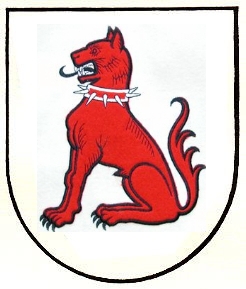|
Zunft Zum Kämbel
Zunft zum Kämbel ("Kämbel guild") is a guild organisation in Zürich, Switzerland. The guild was established in 1336; the guild house, Haus zur Haue, is situated at Limmatquai. Guild house The present ''Kämbel'' guild house, Haus zur Haue, is situated at the Rathaus bridge on Limmatquai near the Constaffel, Saffran and Zimmerleuten guild houses. ''Zunft zum Kämbel'' was originally a guild of food and wine merchants. Its first tavern and meeting place (''Trinkstube'') was located near the medieval town hall at Münsterhof. The guild house was first mentioned in a 1389 document as ''Kembel''. In 1487 the guild acquired the house ''zum Kämbel'' which still exists at Münsterhof 18. The location at Münsterhof square is seen as a deliberate distancing from the noble houses of the more prominent Zürich guilds. History The origins of the Kämbel guild date back to 1336 when, along with the other medieval Zürich guilds and the knight's association ( ''Constaffel''), it ... [...More Info...] [...Related Items...] OR: [Wikipedia] [Google] [Baidu] |
Zünfte Of Zürich
There are fourteen historical ''Zünfte'' (guilds, singular ''Zunft'') of Zürich, under the system established in 1336 with the "guild revolution" of Rudolf Brun. They are the 13 guilds that predated 1336, plus the ''Gesellschaft zur Constaffel'', originally consisting of the city's nobles. Guilds founded in 1336 There have been two mergers of historical guilds since, so that there are 12 contemporary ''Zünfte'' continuing the medieval guilds: 19th century guilds In the 19th century, with the expansion of Zürich, incorporating various formerly separate villages, a number of new "guilds" were established to represent these. By this time the old guilds had ceased to be tied to specific trades and had acquired a mostly folkloristic and societal function, uniting the upper strata of old and well-to-do clans of Zürich. See also *Sechseläuten *History of Zürich *Gesellschaft zu Fraumünster Gesellschaft zu Fraumünster is a guild–like organisation in Zürich, Switzer ... [...More Info...] [...Related Items...] OR: [Wikipedia] [Google] [Baidu] |
Schweizerischer Burgenverein
''Schweizerischer Burgenverein'' is a Swiss voluntary association dedicated to the study and preservation of medieval castles in Switzerland. Established in 1927 as ''Schweizerische Vereinigung zur Erhaltung der Burgen und Ruinen'' ("Swiss association for the preservation of castles and ruins"; the current name was adopted in 1959), its original purpose was the securing of castle ruins to prevent their further decay. Under the presidency of Hugo Schneider (1955–1972), the focus shifted on archaeological research, including the first systematic excavations of many sites earlier acquired by the association. Since 1975, the association has been a member of the Swiss Academy of Humanities and Social Sciences. During its earlier history, the association served an important function in the preservation of the historical record and archaeological research, a role which was increasingly taken over by state-financed cantonal offices for archaeology since the 1970s, causing the ''Burgenv ... [...More Info...] [...Related Items...] OR: [Wikipedia] [Google] [Baidu] |
Camel
A camel (from: la, camelus and grc-gre, κάμηλος (''kamēlos'') from Hebrew or Phoenician: גָמָל ''gāmāl''.) is an even-toed ungulate in the genus ''Camelus'' that bears distinctive fatty deposits known as "humps" on its back. Camels have long been domesticated and, as livestock, they provide food (milk and meat) and textiles (fiber and felt from hair). Camels are working animals especially suited to their desert habitat and are a vital means of transport for passengers and cargo. There are three surviving species of camel. The one-humped dromedary makes up 94% of the world's camel population, and the two-humped Bactrian camel makes up 6%. The Wild Bactrian camel is a separate species and is now critically endangered. The word ''camel'' is also used informally in a wider sense, where the more correct term is "camelid", to include all seven species of the family Camelidae: the true camels (the above three species), along with the "New World" camelids: the llama, ... [...More Info...] [...Related Items...] OR: [Wikipedia] [Google] [Baidu] |
Sechseläuten
The ''Sechseläuten'' (Zürich German: ''Sächsilüüte'', "The six o'clock ringing of the bells") is a traditional spring holiday in the Swiss city of Zürich celebrated in its current form, usually on the 3rd Monday of April, since the early 20th century. Burning of the Böögg Following the parade of the Zünfte (guilds), the climax of the holiday is the burning of Winter in effigy, in the form of the ''Böögg'', a figure of a snowman prepared with explosives. The custom of burning a rag doll called ''Böögg'' predates the ''Sechseläuten''. A ''Böögg'' (cognate to '' bogey'') was originally a masked character doing mischief and frightening children during the carnival season. History The roots of the festival go back to medieval times when the first day of summer working hours was celebrated in the guildhalls across the city. City ordinances strictly regulated the length of the working day in that era. During the winter semester the workday in all workshops lasted a ... [...More Info...] [...Related Items...] OR: [Wikipedia] [Google] [Baidu] |
Tages-Anzeiger
''Tages-Anzeiger'' (), also abbreviated ''Tagi'' or ''TA'', is a Swiss German-language national daily newspaper published in Zurich, Switzerland. History and profile The paper was first published under the name ''Tages-Anzeiger für Stadt und Kanton Zürich'' in 1893. The founder was a German, Wilhelm Girardet. Its current name, ''Tages-Anzeiger'', was adopted later. The paper is based in Zurich and is published in broadsheet. Its owner and publisher is Tamedia and its editor is Res Strehle. Although ''Tages-Anzeiger'' is a national newspaper, it focuses mainly on the Zurich region. Circulation The circulation of ''Tages-Anzeiger'' was 70,000 copies in 1910. It rose to 83,000 copies in 1930 and to 116,000 copies in 1950. In the period of 1995–1996 ''Tages-Anzeiger'' had a circulation of 282,222 copies, making it the second best-selling paper in the country. In 1997 its circulation was 283,139 copies. The circulation of the paper was 280,000 copies in 2000. ''Tages-Anzeiger' ... [...More Info...] [...Related Items...] OR: [Wikipedia] [Google] [Baidu] |
Gesellschaft Zu Fraumünster
Gesellschaft zu Fraumünster is a guild–like organisation in Zürich, Switzerland, not yet associated with the Zünfte of Zürich as of 2015. History of Gesellschaft zu Fraumünster In medieval times, in Zürich all female and male ''Bürger'' were members of the guilds, but beginning in the 19th century women were no more tolerated within the guilds then more as ''decoration'' of their men being still members of the guilds of Zürich. The history of the ''Gesellschaft zu Fraumünsters'' dates back to the late 9th century when the abbess of the Fraumünster Abbey (853 A.D.) in fact reigned the city of Zürich as ''Fürstäbtissin'' (imperial abbess) nominated by the king of the Holy Roman Empire, among them Katharina von Zimmern. ''Gesellschaft zu Fraumünster'', being the society of the former noble women of the Fraumünster Abbey, was established in 1989. Now, the honorable women of the society cultivate the virtuous habits of the former abbey by p.e. honoring the work ... [...More Info...] [...Related Items...] OR: [Wikipedia] [Google] [Baidu] |
2015 Sechseläuten - Umzug - Zunft Zum Kämbel - Bürkliplatz 2015-04-13 16-14-15
Fifteen or 15 may refer to: *15 (number), the natural number following 14 and preceding 16 *one of the years 15 BC, AD 15, 1915, 2015 Music *Fifteen (band), a punk rock band Albums * ''15'' (Buckcherry album), 2005 * ''15'' (Ani Lorak album), 2007 * ''15'' (Phatfish album), 2008 * ''15'' (mixtape), a 2018 mixtape by Bhad Bhabie * ''Fifteen'' (Green River Ordinance album), 2016 * ''Fifteen'' (The Wailin' Jennys album), 2017 * ''Fifteen'', a 2012 album by Colin James Songs * "Fifteen" (song), a 2008 song by Taylor Swift *"Fifteen", a song by Harry Belafonte from the album '' Love Is a Gentle Thing'' *"15", a song by Rilo Kiley from the album '' Under the Blacklight'' *"15", a song by Marilyn Manson from the album ''The High End of Low'' *"The 15th", a 1979 song by Wire Other uses *Fifteen, Ohio, a community in the United States * ''15'' (film), a 2003 Singaporean film * ''Fifteen'' (TV series), international release name of ''Hillside'', a Canadian-American teen drama *F ... [...More Info...] [...Related Items...] OR: [Wikipedia] [Google] [Baidu] |
Staatsarchiv Zürich
Staatsarchiv Zürich, formally the Staatsarchiv des Kantons Zürich, are the state archives of the Swiss Canton of Zürich and its legal predecessors, in particular the former city republic of Zürich. History The state archives host the administrative records of the Canton of Zürich, as it was established in 1803 in its current form. It also preserves the administrative records of the predecessor of the Canton of Zürich, so the records of the Helvetic ''Kanton Zürich'', and in particular of the old city-state Zürich until 1798. In addition to being the "official memory of the administration", it is a versatile documentation and facility for scientific research and for the public. The 4 February 1837 marked the beginning of a new era in Zürich's archives, when Hans Jakob Ammann was elected by the cantonal authorities as the director of the ''Staatsarchiv''. He succeeded the previous "registrar" historian Gerold Meyer von Knonau, who was later given the title ''Staats ... [...More Info...] [...Related Items...] OR: [Wikipedia] [Google] [Baidu] |
Judicial Murder
Judicial murder is the intentional and premeditated killing of an innocent person by means of capital punishment; therefore, it is a subset of wrongful execution. The ''Oxford English Dictionary'' describes it as "death inflicted by process of law, capital punishment, esp. considered to be unjust or cruel". Example An early case in which charges of judicial murder were raised was the Amboyna massacre in 1623, which caused a legal dispute between the English and Dutch governments over the conduct of a court in the Dutch East Indies that had ordered the execution of ten English men accused of treason. The dispute centered around differing interpretations of the legal jurisdiction of the court in question. The English believed that this court had not been competent to try and execute these EIC members, and so believed the executions to have been fundamentally illegal, thus constituting "judicial murder". The Dutch, on the other hand, believed the court to have been fundamentally compe ... [...More Info...] [...Related Items...] OR: [Wikipedia] [Google] [Baidu] |
Hermann Haller (sculptor)
Hermann Haller (24 December 1880 – 23 November 1950) was a Swiss sculptor. His former studio in Zurich can be visited. Works * Hans Waldmann equestrian statue (1937) at Münsterhof Münsterhof (literally: Fraumünster abbey courtyard) is a town square situated in the Lindenhof quarter in the historical center of Zürich, Switzerland. Münsterhof is the largest town square within the ''Altstadt'' (old town) of Zürich, and i ... in Zürich, commissioned work by the Kämbel guild *Mädchen mit erhobenen Händen (1939) in Zürich * Oskar Bider memorial (1924) in Bern * Belvoirpark fountain statue (1923) in Zürich *Schauende (1922) in Köln, Rheinparkweg References File:Kleine Schanze Bern 04 10.jpg, Oskar Bider memorial in Bern File:Hans Waldmann - Reiterstandbild - Fraumünster - Münsterbrücke 2010-08-27 17-42-38.jpg, Hans Waldmann statue in Zurich External links * * 1880 births 1950 deaths 20th-century Swiss sculptors 20th-century Swiss male artists< ... [...More Info...] [...Related Items...] OR: [Wikipedia] [Google] [Baidu] |


